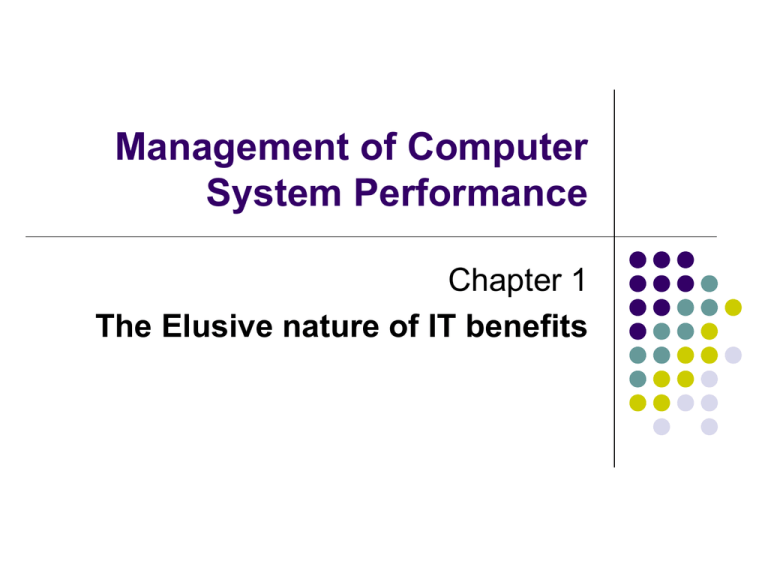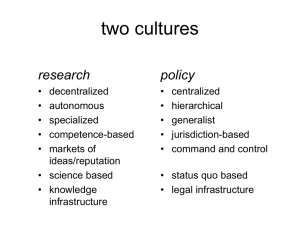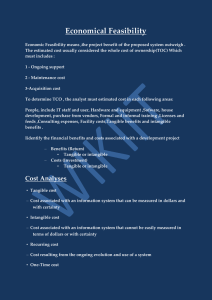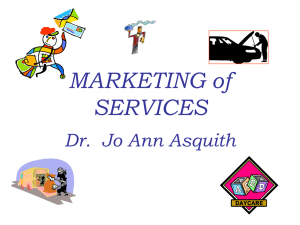Management of Computer System Performance Chapter 1 The Elusive nature of IT benefits
advertisement

Management of Computer System Performance Chapter 1 The Elusive nature of IT benefits The Elusive nature of IT benefits Objective: Students should be able: to identify benefits of IT application 2 Chapter 1: The Economics of Information The quantification of Information and its value to the organization remains one of the most critical issues facing any firm. The Economics of Information is defined as a: systematic series of concepts and theories that explain the role which information and information systems play in assisting individuals or organizations in their conception, production and delivery of goods and services both in the public and private sectors. 3 The Economics of Information IT has been in use for business purposes for arguably 40 years. IT is at last crossing into the mind of management that it is a tool that is essential to serve management. Historically, it was associated with a tool to support, or occasionally augment manual operations. IT solutions are mature and can effectively replace manual operations and offer new business opportunities. This requires Business Process Changes to optimize efficiency. Management is paid to optimize the return on investment. IT is critical in this. 4 Investment Considerations Forrester Research reports that corporations will spend approximately 3% of their revenues on EBusiness procurements in FY2002[i]. This 3% investment may realistically equate to 4060% of that firm’s entire capital investment budget. Unfortunately, not every project can be funded. There is no guarantee that those that are funded will generate the anticipated benefits. The projected benefits of a capital expenditure into an EBusiness solution are legitimately brought under scrutiny by executive management. [i] Surmacz, Jon, April 10, 2002 Nuts-and-Bolts Investment accessed May 08, 2002 from http://www2.cio.com/metrics/2002/metric349.html 5 IT Project Investment IT Project Investment must be done selectively and based on good data. Data must be acquired consistently and completely for optimal use. You guess right, things work. Guess wrong and you loose money. Managers are paid NOT to guess on issues regarding finance. Failure to recognize the issues with financial analysis is worse than guessing. 6 The Economics of Information IT Project Investment has at least one of these three major goals: Replacing manual operations to reduce costs. Adding new sales or marketing channels to generate new or additional revenues. Optimizing customer satisfaction The investment in the systems to address these issues is usually expensive and may constitute a major investment in capital resources. The creation of these “systems” should be done methodically and should follow certain established and proven processes and procedures. Each is creation process should use a Project Management methodology. 7 Costs and Benefits Problem: Whenever possible, define what exactly are the costs and benefits of a project before it is built. What’s at risk? Stats on IT Projects. High failure rates and high costs to the enterprise. 30% of IT projects never reach fruitful conclusion Waste–$75 billion annually in 2001 51% exceed budget by 189% and deliver only 74% functionality THERE IS A PROBLEM HERE! 8 Costs and Benefits Accordingly, The following must be accomplished: The measurement of the complete investment to accomplish the goals of the IT project This include both IT and non-IT costs The measurement of the benefits that are expected of the investment This includes quantifiable and intuitive benefits. 9 Costs and Benefits There is a need to accomplish these measurements effectively. Executive management should insist on this. There is a need to select only the best projects with the highest probability to succeed. Management must have a way to compare one IT investment opportunity to one another. 10 IT Benefits and Measurements The four consistent areas by which IT benefit is measured as as follows: 1. 2. 3. 4. Benefits and identifiable performance improvements. Information System Reach Other tangible and intangible benefits. Benefit evolution These categories are occasionally represented using other terms but the concept is consistent. They are NOT mutually exclusive but represent approaches to benefit analysis and may be combined. 11 Benefits and Identifiable Performance Improvements. The first technique is the quantifiable measurement of benefits. This is complimented by the identification and quantification of measurable performance improvements. Uses fixed valuations for savings and revenue increases. Valuation is based on efficiencies gained. No unique or special technique are usually required. Focuses on the benefits aspects of valuation. 12 Information System Reach Refers the ability of an IT system to integrate operational components of the firm into one single solution. This approach attempts to identify the many secondary benefits that occur when an IT system is made operational. There are many cause and effective issues that must be analyzed. 13 Tangible and Intangible Benefits. Tangible benefits are associated with clear elements such as staffing changes or reductions from the implementation of an IT system. An SCM deployment allows the procurement department to re-do its processes and reduce the number of FTEs. This is a clear and Tangible benefit to the company (not the laid off FTEs) 14 Tangible and Intangible Benefits. Intangible or soft benefits could be non-direct. In the SCM example, most manufacturing firms have expeditors. An SCM could make the information needed by the expeditors much more readily available, thus reducing the high turnover rate within that department due to the stress. Certain deployments, such as a corporate Web Site in the mid-1990s provided some value to sales and marketing by increasing requests for brochures but the fact that the site was there had an intangible benefit of increasing the brand awareness of that firm to the consuming population of their products. 15 Other Tangible and Intangible Benefits Tangible – (capable of being appraised at an actual or approximate value) refers to exact benefits that be derived from an IT solution being deployed. Increase in production output from automating a process in a steel mill. Intangible benefits are derived by removing workers from an unpleasant task. The valuation of intangibles are even more difficult to accomplish. 16 Benefits and identifiable performance improvements. CAUTION – CAUTION – CAUTION – CAUTION Often, firms inappropriately use unique benefit models in identifying IT worth. Why should IT be treated differently from any other capital intensive model? Management needs to: Look at the benefit Look at the costs Look at the probability that the estimates are correct Judge the viability of the project by itself. Compare it to other capital intensive projects and Make a decision to authorize it or reject it and then move forward. That decision is only as good as the data it is based upon 17 Benefits and identifiable performance improvements. Unique IT models obfuscate comparative data. Standard benefit analysis techniques should be used for quantifying the value of other elements of a company. The variables may be more difficult to quantify within IT projects but the answer is more valid. 18 Benefits and identifiable performance improvements. An example, a firm deploys a Supply Chain Management system where vendors are allowed to received purchase orders for commodities via an on-line system such as those offered by Office Depot or Staples. This reduces labor costs and cuts the procurement cycle by 40%. Purchased products to be delivered directly to the end user instead of the warehouse eliminating handling. Direct delivery eliminates warehouse demurrage. Benefits are thus known quickly through labor savings and performance improvements are recognized by the shorter delivery cycle. 19 Benefit Evolution IT benefits should be measured over time and the value will change. An on-line portal may have little value in terms of Tangible or Intangible benefits generated when it is first made operational. However, over time, its value should increase. Conversely, the use of a desktop departmental accounting system will decline in value as a corporate wide ERP systems is made operational. The predicted value of the system is never met 20 Benefit Evolution Benefit Evolution is the progression of the usefulness of the IT offering over time. Depending on the subject IT solution or system, it may have a benefit life cycle. A. As the project is implemented, few people know how to use the system and its use starts off slow. B. As the users learns the system, numbers increase and benefit increases until it peaks. C. As the technology gets older, benefits decrease over time. Users find other systems. (ref: Moore’s Law) D. The system moves into the mode where maintenance is costing more than any benefit. End of life cycle. 21 Benefit Evolution Again using the SCM system as an example, the initial deployment optimized the use of dedicated and custom system code to allow the suppliers to communicate with the company. This is costly to maintain. This system is being replaced with a reverse auction, web and XML enabled solution. The original system’s benefits are declining. It’s benefits were evolutionary. The new system’s benefits are also evolutionary as well. Benefits change over time. 22 Investment, Value and Economics IT investment is similar in concept to that of a machine tool or any other similar capital resource purchase. It must be used to derive value to the corporation. A $6500 firewall is useless unless it is used to protect the corporate network. A million dollar ERP system may save money only if it is successfully implemented and used through out the corporation. 23 Investment, Value and Economics This is the dichotomy. If we don’t use it, what will it cost us? If we do use it, what will we gain? Compare both to the purchase price If the network is attacked, then the value of the firewall is there but the amount of damage and the cost of that damage would have been done is unknown. The $1M ERP system may save $.5M annually but this is not known in advance in quantifiable terms. So the question in both cases, in real money terms, what is the Profit and loss components of each of those systems. What is the benefit. 24 Investment, Value and Economics “Investment” is not only in the IT systems, software and infrastructure (which can be significant). IT systems optimize processes. In Business Process reengineering, processes seldom, if ever survive in tact, when an IT system is delivered to replace or enhance them. Therefore, investment also includes processes, users of those processes and the time and productivity impacts associated with those process changes. 25 Investment, Value and Economics The Business Process and IT investment cascade Changes to the Process and practices IT investment to Supported improvements Business Performance Improvements Improved Profit and ROI 26 Identifying Benefits and Value As an extension of the previous statements, then to conclude that IT investment as standalone expenditures cannot be associated with value. The value is derived from both the benefits of their use as compared to the cost of their use. Benefits = efficiencies gains + cost reductions. Costs = System Cost + deployment costs + operational costs. 27 Identifying Benefits and Value Benefits efficiencies gains = better access to information resulting in improved performance both directly and indirectly. Hard to Quantify cost reductions = elimination of costs associated with resource allocation or use. Easy to Quantify. 28 Identifying Benefits and Value Costs System Costs = These are the primary (first) costs of the IT system. These include the software licenses and related OEM maintenance contracts, the hardware and related OEM maintenance contracts and new infrastructure and related OEM maintenance contracts. (OEM=Original Equipment Mfg.) Deployment Costs = The costs to bring the system online and to an operational status. This includes the labor that is required to set up the new system as well as install any new infrastructure such as additional cabling and data center build out. It can include operational interruptions to implement the new system as well as the training costs for the users. 29 Identifying Benefits and Value Costs Operational Costs = These are the costs associated with the operation of the system. These costs may be incremental costs by assigning additional support duties to existing staff or be new costs by requiring new staff trained on the new system or support infrastructure. These would include on-going Help Desk, license renewals, incremental power costs, Data Center Operations (7x24x365 if needed). System maintenance workers for system updates for patches and bug fixes. 30 Identifying Return on Investment The preceding list of costs and benefit elements is not 100% inclusive nor is it intended to be. It is meant to outline elements to the student to allow them to begin recognizing costs and benefits. Return on Investment is calculated by computing the (Benefits/Costs) for a specific time. In that this ratio will change over time, a subsequent time line valuation should be undertaken as well. 31 The Stakeholders of IT Project Benefits IT Projects are funded by departments and organizations. Their goal is to increase efficiency and thereby reduce costs. For every successful project, there are a series of interested participants and observers, each will different levels of interest in the project. These parties are identified as follows: 32 The “Interested Parties” The Sponsor – The individual who has requested that the project be undertaken. They usually get or provide the funding and face the executives. The Stakeholders – Those who are affected by the project and its implementation, The Project Manager – The individual responsible for the management of the project. Project Team – The grunts. Individuals tasked to perform the work identified in the project plan. 33 The Stakeholders of IT Project Benefits Who are stakeholders? Financial sources and Corporate executive/Senior staff End users External groups, auditors, public investors, taxpayers The Client or Project sponsor Program manager Project team Team Members such as subcontractors, outsource contractors and consultants. Each has some form of vested interest. Each may be impacted by the valuation of the project. 34 The Stakeholders of IT Project Benefits The impact of the valuation of the project may be good or bad so do not assume that everyone looks at a project the same way. The consumption of resources for one project is taking away resources for another. As such, there may be supporters and nonsupporters within the group of stakeholders. This becomes apparent as soon as you put forth your benefit analysis and the assumptions are challenged. 35 The Stakeholders of IT Project Benefits Influences on project assumptions Contingency Risk System resources New technology Design changes Quality and reliability functions Management considerations Target audience 36 The Stakeholders of IT Project Benefits The identification of the stakeholders may not be easily identified. Project Managers use several of the following methods to identify these individuals Focus groups Surveys Interviews Mistakes are common. Several reasons for this are: Incorrect assumptions Unclear or missing information for decision making. Inconsistent interpretation of data. 37 Summary Business Exist for one reason, optimizing shareholders wealth. IT projects are critical to accomplishing this. The selection of optimal IT projects are key to meeting this goal and allowing management to succeed. Large, diverse firms may have as many as 8-900 IT projects going on at any one time and many more identified as needing funding. Selection of the optimal product is critical. 38 Summary Ideally Benefits should be identified and quantified before an IT project is implemented and costs incurred in its development and/or deployment. The primary benefits are usually quickly identified. The secondary and tertiary benefits make the gross benefit more nebulous to quantify. The same is true for the cost components of any project. 39 Summary The concept of IT Value is a combination of factors. Benefits are both tangible and intangible. Benefits are evolutionary. Cost benefit analysis remains a key tool for managerial decision making. Stakeholders must be recognized within the cost/ benefit analysis. Their information is critical. They are the ones who will receive the benefit and will pay the cost, 40 Groups Form into Groups Email me by next Session, at Discussion Board the following information: Name of each group Member Email address of each group Member Phone number of each group member Optional information Any general questions or concerns on the class. Business that you are thinking about selecting and why. 41 Questions & Home Work Questions? Homework Read the CIO Article on Celanese. http://www.cio.com/archive/011503/erp.html Be prepared to: Discuss the Issues. Discuss the solutions. Discuss the Cost Valuation 42




